What's the best time to visit Petra?
The best time to visit Petra is during March-April or October-November. Both periods offer mild weather in the 70s and 80s with limited rain, making conditions just right for exploring the carved cliff facades and ancient tombs that make the city so striking. Nighttime music festivals, nearby villages with special sites like Wadi Musa’s Moses’ Spring, and culinary delights at the Petra Kitchen are highlights of visiting during these months.
The ancient rock-hewn city of Petra, known as the Rose City for its pink sandstone, fascinates even the most seasoned traveler with its intricate detail — it’s as much a work of art as it is a historic site and architectural wonder.
This city in the desert was settled by Arabian nomadic peoples, the Nabataeans, who prospered as desert traders and decided to give up wandering in favor of building permanent structures right into the sandstone cliffs of Petra as they gathered and stored up wealth.
Today, you can wander paths and canyons through the sandstone cliffs where important structures, from treasuries and monasteries to amphitheaters and temples. Photos can show you that Petra is awe-inspiring, but seeing the scale and detail up close is mind-boggling.
If you’re thinking about planning a trip to see it for yourself, you should start with the best time to visit Petra. Parts of the year are better for a visit than others.
Some months are sweltering here among the sandstone cliffs in the desert, some see dustings of snow with cold temperatures, and others are very crowded or expensive. Let’s take a look at the overall best time to visit Petra along with the cheapest, least busy, and worst months to go.
We’ll show you what you can expect month-to-month in Petra, like weather conditions, prices, crowds, and seasonal events. This will help point you in the right direction as you start to nail down your travel dates!
Overall Best Time to Visit Petra
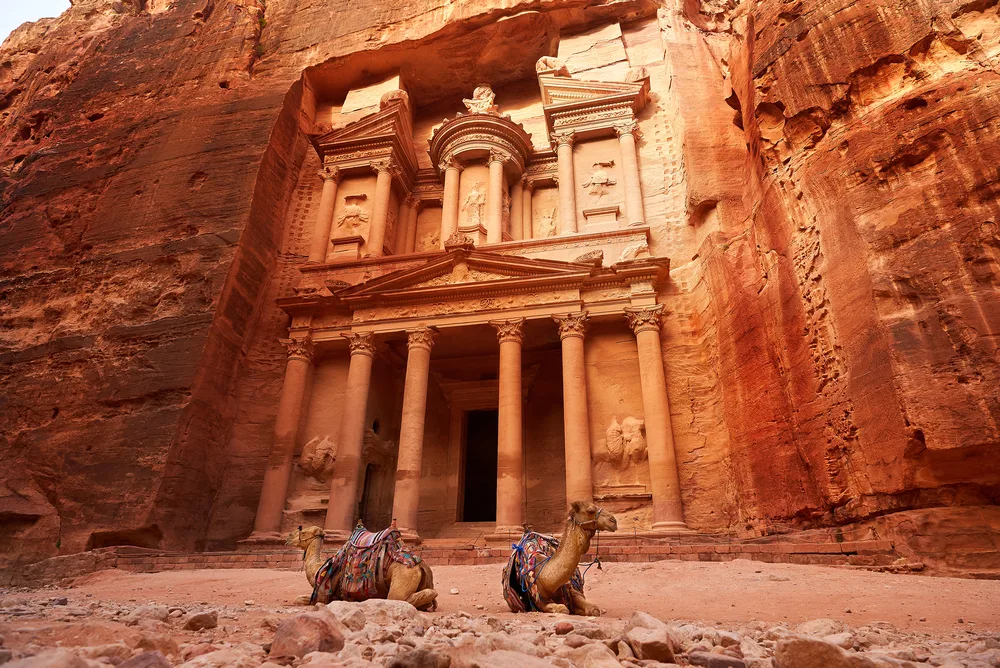
Aleksandra Kossowska/Shutterstock
The best time to visit Petra is from March to April and October to November. These mild shoulder season months are warm, not hot, and see minimal rain for perfect sightseeing conditions.
The weather in Petra, Jordan is just right during March-April and October-November. You’ll skip the hot, dry summer and enjoy more moderate conditions that are perfectly suited for spending entire days exploring the nooks and crannies of this ancient rock city.
- March: 44-69°F; 2 rainy/snowy days
- April: 52-79°F; 1 rainy day
- October: 56-84°F; 0-1 rainy days
- November: 46-71°F; 1-2 rainy days
This is the best time to journey through the narrow siq, or gorge (it can feel claustrophobic at points) that leads to the ruins of Petra and puts you right in front of the most famous structure here: Al Khazneh, or the Treasury. It’s much hotter in the summer and cold and snowy during the winter.
Once you’re inside Petra, you’ll be able to walk past amazing carved buildings and tombs, like the Street of Facades where massive Nabataean tombs line the path and a crumbling amphitheater built to accommodate 4,000 people.
Climb steps inside Petra to reach the high-up Ad Deir, or Monastery, and access some of the best views among the ruins. The High Place of Sacrifice is above Ad Deir, and while the weather is mild, the hike to either one is much more comfortable.
During the spring and fall, it’s a great time to experience Petra by Night. The ancient city is illuminated with thousands of flickering candles that cast a warm glow over the pink sandstone and adds a layer of ethereal beauty to the ruins. It’s perfect for an October trip to escape the heat.
You’ll likely stay in nearby village of Wadi Musa (“Valley of Moses”), so spend a little time exploring the town and its authentic eateries, markets, and Turkish baths.
In a chapel near the King’s Way Hotel in Wadi Musa, you can see the Moses Spring, the site where Biblical Moses is said to have struck a rock and uncovered a spring that brought much-needed water to his followers.
The best time to visit Petra can be expensive, especially during March and April. We analyzed data from Google Hotels and Skyscanner to find out how much it costs to visit in March, April, October, and November:
- March: $240/night; flights from $624
- April: $242/night; flights from $895
- October: $175/night; flights from $642
- November: $195/night; flights from $639
While April is the most expensive month to visit Petra (March is in 2nd place), October and November offer much more affordable prices on hotels. March flights to Petra are surprisingly affordable.
As far as events, Petra only has a few during these months. Here are some to keep an eye out for if you’re hoping to get involved in the local culture:
- Ramadan (Jan/Feb/Mar/Apr) celebrates the Islamic holy month with prayer and fasting across Jordan, which can create some difficulties as restaurants and businesses may close during the day; Petra is typically less affected and you’ll be fine to drink and eat here
- Petra Light Festival (late Apr-May) brings stunning visual shows to the city with projections on the facades of the buildings carved into the cliffs that change and warp the appearance with musical accompaniment
While Ramadan may or may not happen during your stay (it sometimes falls during January or February), you may want to pack some snacks and drinks for yourself in case you find the Petra Kitchen restaurant closed.
Cheapest Time to Visit Petra
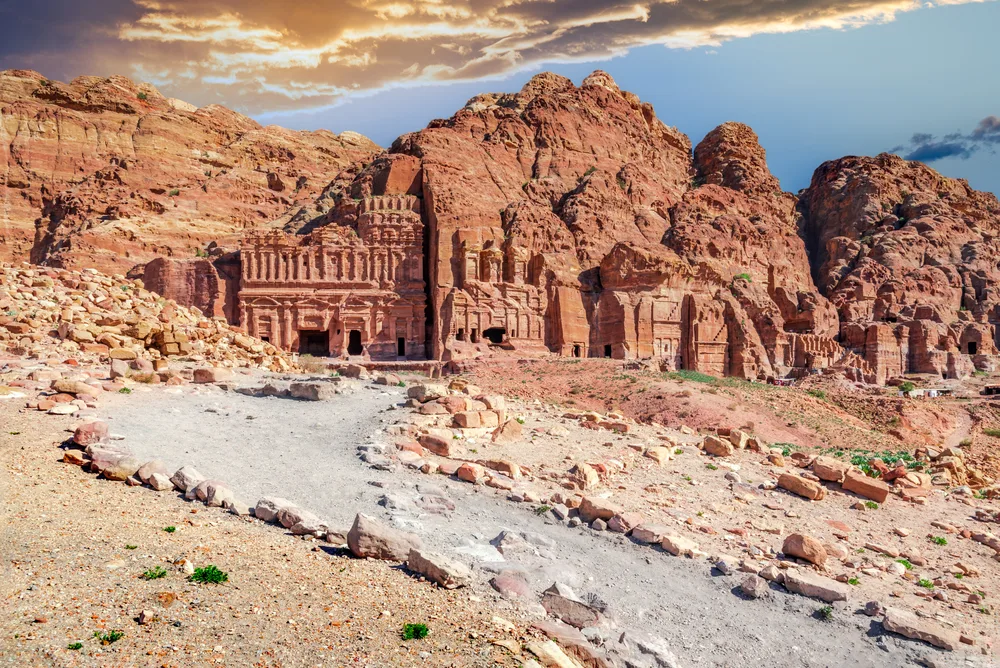
ecstk22/Shutterstock
May to June is the cheapest time to visit Petra. Average hotel prices fall well below $100/night and airfare is more affordable during these months, which see warm weather in the upper 80s to low 90s with very little rain.
Petra is so spectacular to visit that it can be tempting to plan a trip here, even if travel funds are limited. Luckily, the months of May and June offer significant savings that can make it much cheaper to visit Petra.
The weather will be warm, but not sweltering during May and June. May is a bit more comfortable with highs in the upper 80s, but both months are hot and dry. You’ll want to bring plenty of water on your trip into the city!
- May: 58-87°F; 0-1 rainy days
- June: 63-93°F; 0 rainy days
Since you’ll be here during the dry season, you won’t have to deal with rain showers or storms while you’re exploring the ancient city of Petra or cool destinations nearby. Along with saving money on your trip, this can be a real bonus!
May and June are a bit hot for taking on the grueling climbs up stairs to reach the Ad Deir Monastery or High Place of Sacrifice, but dedicated travelers can still make the ascent for some stunning views over the area.
Dine at the Petra Kitchen to experience a traditional Jordanian meal in the most scenic, authentic setting you can imagine: among the ruins of Petra. Enjoy a 5-course meal with soup, cold and hot mezza, salad, and a main course in an intimate setting that immerses you in the city’s history.
These are great months to take a guided tour through Petra to ensure you’re understanding what you’re witnessing as you go. Guides can help direct you through more shaded areas in the gorge and show you little-known spots with extensive history.
Take a 5-night cooking class if you’ll be staying near Petra for a few days. Each evening, you’ll return for nightly sessions that include shopping trips at the local market, transportation to and from Petra, cooking instruction, and dining on traditional Jordanian food.
Since May and June are the best months to visit Petra for affordable prices, you’ll want to get an idea of how much you’ll pay for a hotel and flight this time of year. Take a look at estimates from Google Hotels and Skyscanner data below:
- May: $76/night; flights from $617
- June: $77/night; flights from $702
You could pay as little as $1,150 for a 7-day trip to Petra during May, the overall cheapest month to visit. That week-long cost bumps up to about $1,240 in June, but these still offer huge savings over months like April and March.
July and August are similarly cheap, but hotels cost $71-88/night with flights starting at $839-$885 round trip, so they’re not quite as affordable as May or June.
While you’re in Petra during May or June, you might be able to catch the Petra Light Festival with digital projections and music on the facades of the buildings or the 5-day Medaina festival in late May that’s split between Petra and nearby Wadi Rum.
If you’re hoping to save on your trip to Petra, May and June are the best months to do it — but May offers slightly cooler weather, the lowest prices of all, and more events.
Least Busy Time to Visit Petra
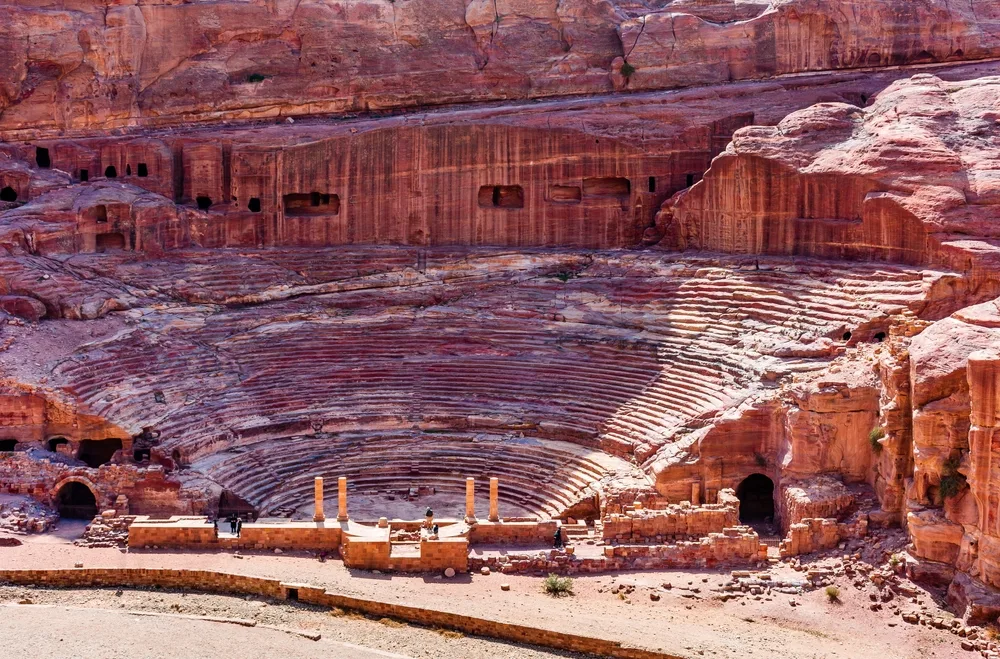
Artur Sniezhyn/Shutterstock
The least busy time to visit Petra is January-February and June-July. You’ll note smaller crowds touring the city during these months that see cool to hot temperatures and little rain, but higher prices on flights and hotels.
The cool months of January and February see small amounts of rain (or snow) and give way to hot, dry weather in June and July. All 4 months offer much smaller crowds than the peak fall season:
- January: 37-59°F; 3-4 rainy/snowy days
- February: 39-62°F; 2-3 rainy/snowy days
- June: 63-93°F; 0 rainy days
- July: 67-96°F; 0 rainy days
Even at the wettest point (chilly January), Petra may only see 0.8″ of rainfall with 3 or 4 rainy or snowy days — not exactly torrential downpours or blizzards, so it won’t be a problem for your visit if you can deal with the cold.
June and July are devastatingly dry and hot. You’ll really feel the heat as you’re surrounded by rock as you wander through the maze-like pathways of the ancient city. It can be miserable in the afternoon.
For that reason, visiting in June or July calls for setting out early in the morning, wearing lightweight clothing, plenty of sun protection, and bringing ample water to drink throughout the day.
Bring a picnic to nearby Al Baida (or Beidha), a Neolithic archaeological site surrounded by mountains and forests. It’s a UNESCO World Heritage Site like Petra with temples and tombs of its own and boasts incredible views not far from the ancient city.
Take a day trip to see the 12th-century crusader castle, Montreal (or Qal’at ash-Shawbak) built into the side of Royal Mountain. You’ll see the fortress, wells, a prison, tiny secret passageways, a subterranean spring, two churches, and an old market.
The Petra by Night Concert Series is held 3 nights each week on Monday, Wednesday, and Thursday. During June and July, an evening visit is much more pleasant without the hot sun. Enjoy a candlelit walk through the city with traditional Bedouin music in front of the Treasury at the end.
While you’ll enjoy less crowded conditions during January-February and June-July, you can also look forward to prices well below what you’ll pay during busier months. Here’s a look at Google Hotels and Skyscanner data on airfare and hotel prices:
- January: $138/night; flights from $751
- February: $194/night; flights from $740
- June: $77/night; flights from $702
- July: $71/night; flights from $885
June is one of the cheapest months to visit Petra overall, and July offers prices that are almost as affordable. January and February can offer great deals if you want to come when the weather’s cooler.
As far as festivals and events go, it’s possible that Ramadan could fall during January or February (2027-2030) and limit your dining, shopping, and nearby town options as things close down during the day for prayer and fasting.
Other events include the Aqaba Traditional Arts Festival in February, which takes place under 2 hours from Petra in the seaside town of Aqaba with music, markets selling local goods, and more.
Worst Time to Visit Petra
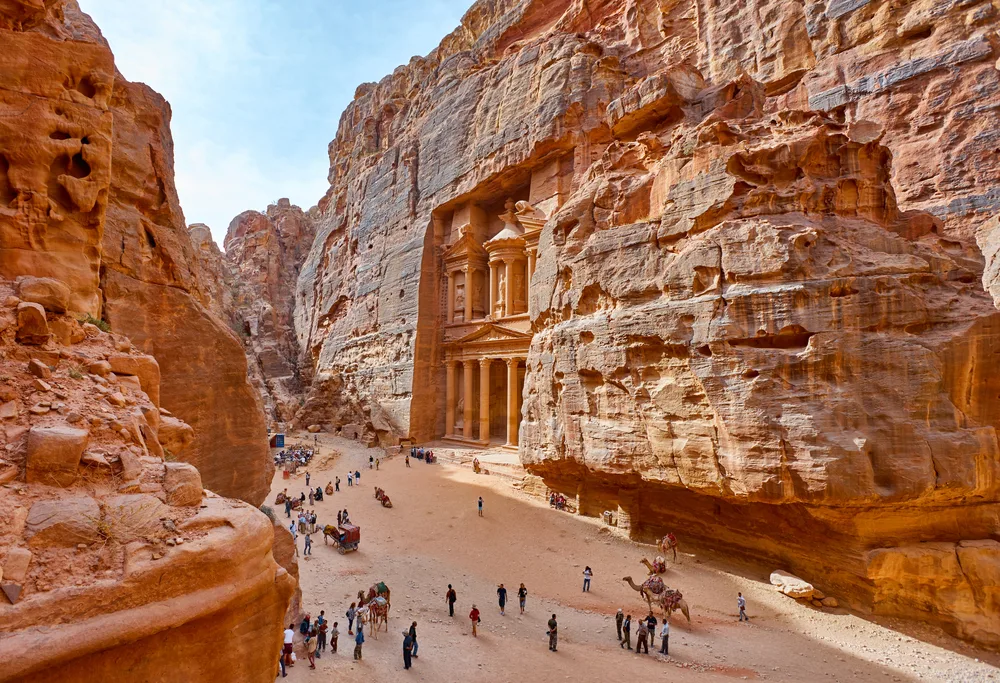
Truba7113/Shutterstock
July through September is the worst time to visit Petra. These are the hottest, driest months of the year and August-September see peak crowds, making tours in the city less enjoyable.
You haven’t experienced heat like this unless you’ve been to desert locales before — with highs in the upper 90s among all the sandstone rock and zero cloud cover, it’s miserable to tour Petra when it’s this hot.
- July: 67-96°F; 0 rainy days
- August: 67-96°F; 0 rainy days
- September: 58-92°F; 0 rainy days
There’s no rain to break through the heat, the rock acts like a heatsink, and the sun shines for 13-14 hours a day. You can see why these months are the worst time to visit Petra.
There’s no real relief from the heat during July, August, and September, and it’s even hot in the shaded areas of the city where cliffs overhang or you wander through deep gorges.
The only way to enjoy a Petra visit without the heat during July, August, or September is by coming at night. Petra at Night tours are offered 3 days a week, on Mondays, Wednesdays, and Thursdays.
Plan your travel dates accordingly and head to destinations like Amman (it’s a little cooler this time of year with highs in the upper 80s) on the days you won’t be in Petra.
One good thing about the worst months to visit Petra is that you can find some nice deals on accommodations and flights. July is the cheapest of these 3 months, but August and September also offer affordable prices (data from Google Hotels and Skyscanner):
- July: $71/night; flights from $885
- August: $88/night; flights from $839
- September: $142/night; flights from $684
While July is the most expensive month to fly to Petra, the low average hotel rates still make it among the cheapest months to visit (aside from May and June).
The only event to speak of during this hot period is the Petra Desert Marathon in early September — and even the most dedicated runners may wilt at the prospect of conquering a half or full marathon in these conditions.
All things considered, you’re better off coming sooner — like cheap May-June — or later, like October-November, for better weather and more pleasant conditions for exploring the city.
Petra by Month: What to Expect
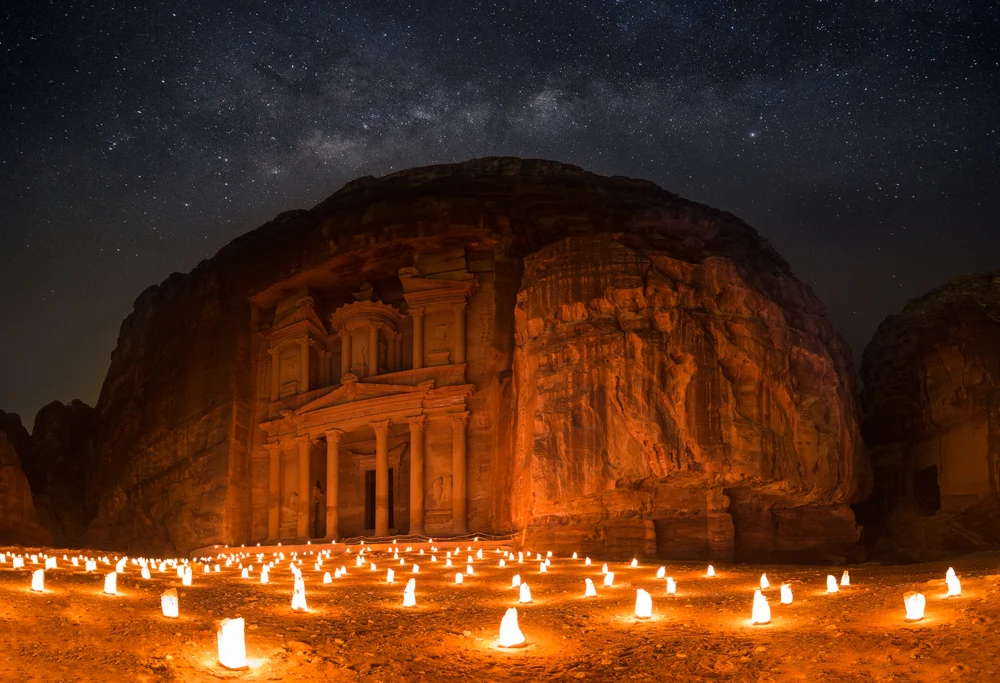
khalid jamal/Shutterstock
Visiting Petra is slightly different from month to month, so take a look at what you can expect in terms of weather, prices, crowds, and events throughout the year to find your perfect travel dates.
January
Mild, cool January sees a little rain and potential snow dustings with highs around 59°F. It’s a great time to explore Petra without overheating! Hotels are priced moderately around $138/night and it’s one of the least busy months to visit. You’ll pay upwards of $751 for a round trip flight this month.
February
February is another of the least busy months of the year in Petra during the “rainy season.” There are only 2-3 days of rain or snow, so it’s not bad with highs around 62°F. This is a great time to climb the stairs up to Ad Deir Monastery for great views. Check out the Aqaba Traditional Arts Festival nearby. You’ll pay about $194/night for hotels and $740+ for flights.
March
March is one of the best months to visit Petra with balmy highs around 69°F and 2 days or rain or a dusting of snow. With hotels around $240/night and flights starting at $624, it’s the 2nd-most expensive month. Ramadan may begin this month and lead to closures of businesses and restaurants around Petra, so prepare by bringing your own snacks and water.
April
One of the best months to visit Petra, April sees warm highs around 79°F with just 1 rainy day. It boasts the popular Petra Light Festival at the end of the month with digital projections on the ancient rock accompanied by music. Hotels cost around $242/night and flights are $895 and up — the most expensive month of the year.
May
As temperatures rise to highs around 87°F, May begins the cheap season with hotels averaging just $76/night and flights starting at $617. It’s the cheapest month of the year to visit Petra and sees very little rain (o-1 days). The major music festival, Medaina, happens at the end of the month over a 5-day period in Petra and Wadi Rum.
June
June is one of the cheapest and least busy months to visit Petra because it’s hot! Highs reach 93°F this month with no rain or cloud cover to cool things down. As a result, tourism slows and hotels drop to about $77/night on average with airfare beginning at $702 round trip.
July
As one of the least busy months of the year, July in Petra is very hot with highs around 96°F and zero rainfall or cloud cover. It can be miserable to tour the city during the afternoon hours, so evening tours are recommended. You’ll pay around $71/night for hotels or upwards of $885 for flights.
August
August sees peak crowds in Petra as the heat reaches its peak, so it’s crowded and hot — one of the worst months to travel here. Hotels are cheap, around $88/night, but flights cost $839 and up. It’s very dry with no rainfall, so attending Petra by Night after the sun sets is your best bet this month.
September
Another month with peak crowds, September finally sees a downward trend in daily highs (around 92°F this month) but still no rainfall or cloud coverage. This month, the Petra Desert Marathon takes place if you’re into running. Hotels charge around $142/night and flights may be as low as $684.
October
The crowds are still present in October, but it’s one of the best months to visit Petra with more comfortable highs around 84°F and 0-1 rainy days. It feels more like springtime in Petra and exploring the rock structures becomes more manageable. Hotels cost about $175/night and flights start at $642 round trip this month.
November
As one of the best months to visit Petra, November sees dwindling crowds with great weather that reaches highs around 71°F. It’s balmy and enjoyable with 1-2 days of rain this month. You’ll pay around $195/night on average for your hotel and upwards of $639 for a round trip flight in November.
December
Moderate and cool, December sees highs around 62°F and up to 3 days of rain or snow. You might see a dusting around the cliffs and mountains of Petra this month, but conditions are much nicer to sightsee around the rock-hewn architecture and tombs. Hotels cost about $143/night with flights upwards of $616 — the cheapest airfare of the year.
Frequently Asked Questions
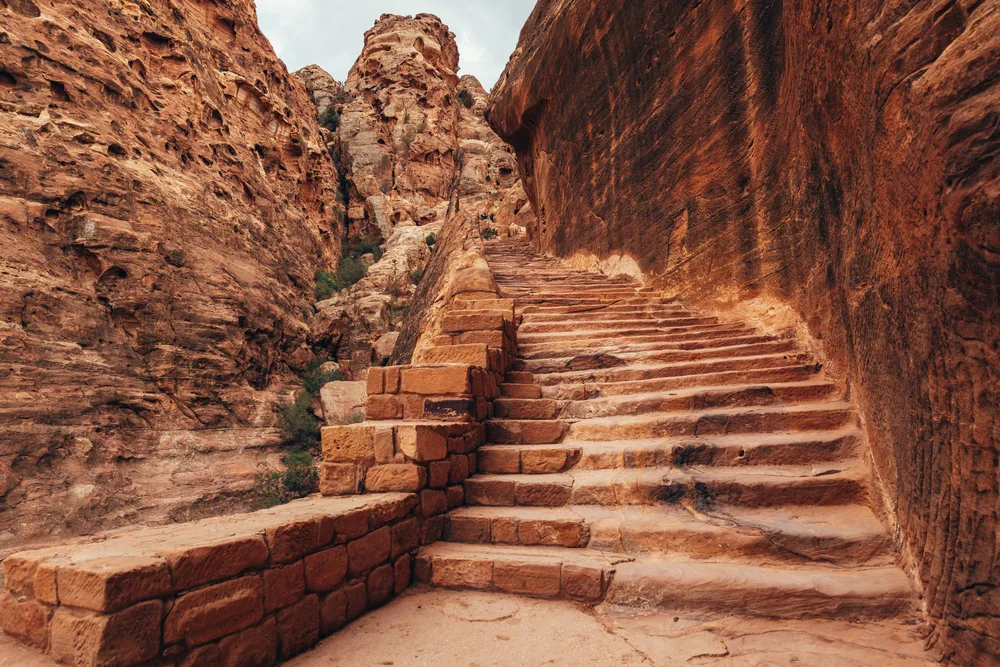
sashk0/Shutterstock
What else should you know before you start planning your trip to Petra in earnest? Take a look at the most frequently asked questions from other travelers below to learn more.
What is the best month to travel to Jordan?
March-May are the best months to travel to Jordan. March and April offer the best weather conditions to explore the rock city with highs from the upper 60s to the upper 70s and minimal rain. May is the cheapest month of the year to visit with warm highs in the upper 80s.
How many days do you need in Petra?
You need 2-3 days in Petra to adequately explore the ancient city in the rock and see the highlights -- Al Khazneh, Ad Deir, High Place of Sacrifice, the Siq, amphitheater, temples, and tombs. Stay in nearby Wadi Rum for easy access to Petra each day.
Which month is best for Wadi Rum?
March-May and October-November are the best months for Wadi Rum, which is about 1.5 hours from Petra. If you come during May, you can attend the Medaina music festival that takes place at Petra in late May with events in Wadi Rum during the final days of the 5-day festival.
How long does it take to walk all of Petra?
It takes about 3.5 hours to walk from the start (Al Khazneh, the Treasury) to the end of Petra one-way. Plan on about 7 hours to walk all of Petra with a little time to take photos and explore around the city as you go. We recommend splitting your trip into at least 2-3 days.
Is the Petra hike difficult?
The Petra hike is difficult in areas, like the steps that lead up to the Ad Deir Monastery or the High Place of Sacrifice. If you start from Little Petra (the “backdoor” entrance by the Monastery), you can get the difficult walking out of the way first and enjoy the more leisurely stroll afterward.
So, What’s the Best Time to Visit Petra Overall?
The best time to visit Petra overall is March-April or October-November. All 4 months see mild, dry weather that’s comfortable for exploring the rock city and most offer moderate prices (except April, which is the most expensive month).
If you’re chasing deals, come between May and June. These months are the cheapest to visit Petra, with May offering the overall lowest prices on hotels and airfare. It’s mild to warm and dry during both months.
January, February, June, and July are the least busy months to visit Petra without big crowds and better chances to see and photograph the structures here. January and February are much cooler than warm to hot June and July.
Try to avoid visiting during July, August, or September, when temperatures are sweltering with no rain or cloud cover and touring the city is only enjoyable at night.
Petra has a mysterious air about it as one of the 7 Wonders of the World. We may never unlock all its mysteries, but it’s certainly fun to try by exploring and appreciating the beauty of this rock-carved city in the cliffs for yourself.
No matter when you choose to go, be sure to take plenty of pictures and don’t be afraid to ascend steps to reach the highest places — the High Place of Sacrifice and Ad Deir — to enjoy the most spectacular views over the entire area.



